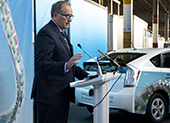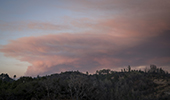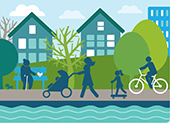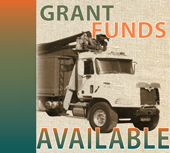|
|

|
|
|
|
February 2020 l Volume 2020-1
|
|
|
|
|
|
|
In this issue, you’ll find articles about a Bay Area wide neighborhood air monitoring project and new wood-burning rule amendments that expand the wood-burning ban year-round when fine particulate pollution is high. Other articles cover CARB’s approval of the West Oakland Clean Air Plan, the development of an extensive odor study for the Milpitas area and and the election of the Air District’s district counsel as president of A&WMA. A summary of current grant opportunities is also included.
|
|
|
|
|
|
|
|
|
|
|
|
|
|
Air District and Aclima Announce Unprecedented Hyperlocal Air Quality Data Program
|
|
| | |
|
In January, the Air District and Aclima announced the roll-out of a cutting-edge air quality data program that will map air pollutants and greenhouse gas emissions in every Bay Area neighborhood — covering more than 5,000 square miles. To gather air quality data, fleets of low-emission cars equipped with air quality sensing devices and software will continuously collect, analyze and map air pollution and greenhouse gas levels as they drive on Bay Area roads. The data will set a baseline for plotting block-by-block concentrations of air pollutants – such as fine particulates, ozone and nitrogen dioxide – and greenhouse gases.
Data will be collected throughout 2020 and early 2021 in all nine Bay Area counties. After the data collection is complete and analyzed, address-based insights into air quality will be publicly available online. Air pollutant levels will be accessible for a region, city or block. This high-resolution picture of air quality will show air pollution hot spots, revealing health disparities and enabling more targeted emissions reduction efforts.
Late last year, the Air District and Aclima initiated data collection in the first community in the program, Richmond-San Pablo, before launching the full regionwide effort last month. The maps for Richmond-San Pablo will be available early this year.
Aclima is a San Francisco-based company that delivers hyperlocal air quality data and insights to improve human and planetary health.
|
|
|
|
|
|
|
|
|
|
|
|
|
Air District Strengthens Wood-Burning Rule to Protect Air Quality During Wildfires
|
|
| | |
|
In November, the Air District’s Board of Directors voted to adopt new amendments that strengthen the agency’s wood-burning regulation and help safeguard public health against the hazards of fine particle pollution, especially during wildfires. In the past, the Air District’s rule prohibited wood burning during Winter Spare the Air Alerts, which occur between the beginning of November and the end of February. The new rule amendments extend the ban on wood burning year-round whenever a Spare the Air Alert is called due to unhealthy levels of particulate pollution. This will ensure that unhealthy concentrations of air pollution, such as those that take place during wildfires, are not increased by wood-burning activities.
Adoption of these amendments is a key part of a larger effort by the Air District to reduce the health and air quality impacts of wildfires. The Air District’s Wildfire Air Quality Response Program is a comprehensive program intended to prevent, prepare for and respond to future wildfires. The program will ensure that health-protective measures and strategies are in place during wildfire smoke events.
Like wildfire smoke, wood smoke contains carcinogenic substances, such as particulate matter and carbon monoxide, which are harmful when inhaled. Exposure to wood smoke has been linked to serious respiratory illnesses and increased risk of heart attacks. The fine particulate pollution in wood smoke is especially harmful for children, the elderly and those with respiratory conditions.
During PG&E Public Safety Power Shutoffs, or other loss of electricity or gas service, there is an exemption in the Air District’s new amendments that allows wood burning when there is no alternate form of heat available for residents. However, unnecessary wood burning is still discouraged during PSPS events because they coincide with increased fire risk and often with wildfire outbreaks, and wood burning would add more air pollution when levels may already be high.
Bay Area residents can find out if a Spare the Air Alert is in effect by:
|
|
|
|
|
|
|
|
|
|
|
|
|
West Oakland Community Action Plan to Improve Air Quality Approved by California Air Resources Board
|
|
| | |
|
In December, the California Air Resources Board voted unanimously to approve Owning Our Air: The West Oakland Community Action Plan, co-authored by the Air District and the West Oakland Environmental Indicators Project. Owning Our Air lays out a series of strategies and measures to be implemented over the next five years by state, regional and local agencies to further air pollution reductions in West Oakland. The Air District’s Board of Directors adopted the plan on October 2, 2019.
West Oakland is bounded by the Port of Oakland, the Union Pacific rail yard and the I-580, I-880 and I-980 freeways. Elevated levels of air pollution in West Oakland are the result of concentrated industrial activity including maritime freight, a rail yard and rail lines, large distribution centers, cement and asphalt plants, a power plant, metal facilities, and small to medium industrial and manufacturing operations. Trucks, cars and the road dust they generate also contribute to elevated emission levels.
The plan was developed as a requirement of AB 617, a state law passed concurrently with re-authorization of California’s cap-and-trade program, the centerpiece of the state’s efforts to reduce climate change. AB 617 recognizes that while California has seen tremendous improvement in air quality, not all communities have benefited equally, and some communities located close to freeways, ports, industry or other large pollution sources need additional focus and resources to reduce exposure levels.
A copy of the Owning Our Air plan, a plan summary and appendices can be viewed and downloaded on the Air District’s West Oakland Community Action Plan web page.
|
|
|
|
|
|
|
|
|
|
|
|
|
Air District Board of Directors Approves Funding for Comprehensive Milpitas Odor Study
|
|
| | |
|
The Air District’s Board of Directors has recently voted to approve funding for a comprehensive odor study in the Milpitas area.
The study will use science-based methods to pinpoint the composition and source of persistent odors in order to identify improvements for better controlling and eliminating these impacts. Statewide organic waste diversion goals of moving waste away from landfills and relying on environmentally sustainable options that reduce climate impacts have changed the waste industry significantly, and impacted waste processing facilities in and around Milpitas.
In 2015, the South Bay Odor Stakeholders Group was formed as a forum for municipal leaders, industry, state and local regulators - including the Air District - and members of the community to collaborate in identifying and resolving odor issues in the South Bay. The group worked closely with Congressman Ro Khanna and Assemblymember Kansen Chu to develop odor mitigation strategies that address community concerns.
Stakeholders expressed the importance of further study in analyzing specific odor compounds and their origination from local waste facilities with the goal of developing near and long-term strategies that can help resolve odor problems in the community.
The study will employ newly available technologies to help identify and quantify odorous compounds. Data will be gathered over a period of a year or more to capture seasonal and operational changes in the waste industry.
The Air District is committed to helping the Milpitas community resolve the odor problems that have significantly affected their air quality in recent years.
|
|
|
|
|
|
|
|
|
|
|
|
|
Air District Counsel Brian Bunger Named President-Elect of A&WMA
|
|
| | |
|
The Air District’s district counsel, Brian Bunger, has been elected 2020 president-elect of the Air & Waste Management Association. The Air District has been a longtime active member of A&WMA, an organization that provides environmental professionals with up-to-date technical, managerial and regulatory information on air and waste issues.
Mr. Bunger joined the Air District in 2000 as the agency’s senior assistant counsel and was appointed its district counsel by the Board of Directors in 2002. Mr. Bunger was previously a member of the A&WMA Board of Directors prior to his being elected president-elect.
Founded in 1907, A&WMA is a nonprofit, nonpartisan professional organization enhancing knowledge and expertise by providing a neutral forum for information exchange, professional development, networking opportunities, public education and outreach to more than 5,000 environmental professionals in 65 countries.
|
|
|
|
|
|
|
|
|
|
|
|
|
Air District Offers Millions in Grants
|
|
| | |
|
The Air District administers a number of grant funding programs that offer incentives for clean air projects. Grant Programs Currently Open:
For Bay Area public agencies and business:
Equipment/Engine Replacement/Repower or Conversion and Infrastructure
- Carl Moyer Program –$10 million is available for eligible projects that upgrade or replace on-road vehicles, school buses, transit buses, off-road and agricultural equipment, marine equipment, and locomotives. Applications are being accepted on a first-come, first-served basis until all funds are awarded. www.baaqmd.gov/moyer
- Community Health Protection Grant Program – $40 million is available for eligible projects that reduce toxic air emissions and ozone-forming pollutants from mobile and stationary sources by replacing old, high-polluting vehicles and equipment. Priority is given to projects in the AB 617-identified communities of West Oakland, Richmond-San Pablo, East Oakland/San Leandro, Eastern San Francisco, Pittsburg-Bay Point area, San Jose, Tri-Valley area, and Vallejo. Community input will play an important role by informing the Air District’s project outreach and project identification processes. Applications are being accepted on a first-come, first-served basis until all funds are awarded to owners of eligible equipment and vehicles by June 2020. www.baaqmd.gov/ab617grants
- Lower-Emission School Bus Program – Funding is available for public school districts, Joint Powers Authorities (JPAs), and contracted fleets in the Bay Area to do bus replacements, engine repowers or electric conversions, natural gas tank replacements, and electric charging and alternative fueling infrastructure projects. Applications are being accepted on a first-come, first served basis until all funds are awarded. www.baaqmd.gov/lesbp
Vehicle Trip Reduction Grant Program
- Bicycle Facilities – Approximately $3 million is available for eligible bicycle facility projects that improve air quality and reduce greenhouse gas emissions by reducing single-occupancy vehicle trips. Bicycle Facility projects include bikeway and bicycle parking projects. Applications are being accepted on a first-come, first-served basis until all funds are awarded. www.baaqmd.gov/tripreduction
Loan Guarantees and Low-Interest Financing
- Climate Tech Finance Program – Subsidized financing is available to help Bay Area facilities adopt emerging technologies that reduce greenhouse gas emissions. Public facilities can apply for loans ranging from $500,000 to $30 million, up to 30-year terms. Small businesses can apply for loan guarantees of up to 90%. This program is open and accepting applications now. www.baaqmd.gov/ctf
Programs for Bay Area residents:
Light-Duty Vehicle Replacement – The Clean Cars for All Program is open to all income qualified Bay Area residents and provides incentives to retire older, high-polluting vehicles and replace them with a newer, cleaner vehicle or with alternative transportation options (e.g. Clipper card). Eligible vehicles for purchase or lease include hybrid electric, plug-in hybrid, or electric vehicles. This program is open and accepting applications now. www.baaqmd.gov/cleancarsforall
Passenger Car and Light-Duty Truck Retirement – The Vehicle Buy Back Program pays Bay Area residents $1,000 per vehicle to turn in their operable, registered, older passenger car or light-duty truck for scrapping. Eligible vehicles are model year 1996 and older. www.baaqmd.gov/vbb
Volkswagen (VW) Environmental Mitigation Trust (Statewide)
Zero-Emission Transit and Shuttle Buses – $32.5 million is available statewide to support early adoption of zero-emission bus technologies to reduce harmful exposure for the State’s most sensitive populations. This solicitation is open and accepting applications for transit and shuttle buses on a first-come, first-served basis. Applications are no longer being accepted for school bus projects. http://vwbusmoney.valleyair.org/
Combustion Freight and Marine Projects – $30 million is available statewide to accelerate the replacement of older, higher polluting diesel engines with the cleanest available technologies. Equipment eligible for replacement includes Class 7 and 8 freight trucks (including waste haulers, dump trucks, and concrete mixers) or their engines (2012 model year and older) that are compliant with current regulations; freight switcher locomotives or their engines (pre-Tier 1); and ferry, tugboat, and towboat engines (pre-Tier 3). This solicitation is open and accepting applications. Projects will be selected on a competitive basis based on the cost effectiveness of NOx emissions reductions. www.aqmd.gov/vw/
Other VW Environmental Mitigation Trust Project Categories – Solicitations for zero-emission freight and marine projects, zero-emission class 8 freight and port drayage trucks, and light-duty zero-emission infrastructure (hydrogen and electric) are anticipated to open in phases through early 2020. www.californiavwtrust.org/
|
|
|
|
|
|
|
|
|
|
|







